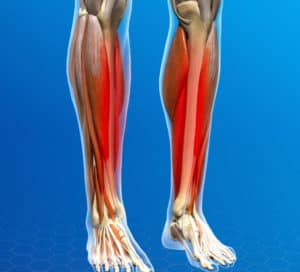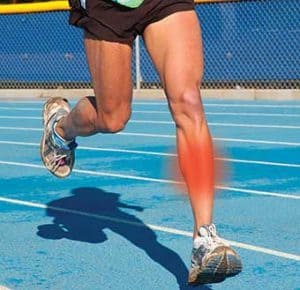
Shin splints can be a huge pain for runners new and seasoned. My first experience with them started during 7th grade cross country practice. We would run laps on the concrete around the pond near my middle school, and my shins would just ache afterwards. I couldn’t even touch the skin over my shins without wincing!
Read on to find out:
- What are shin splints?
- Why do my shins hurt?
- How do you treat shin splints?
What are shin splints?
‘Shin splints’ is a common term for repetitive stress injuries of the shin area, often from muscles putting excessive strain on the bigger of the lower leg bones (the tibia). Shin splints are also called medial tibial stress syndrome (MTSS). Since muscles attach to the tibia, when they are used over and over for high impact activities like running and jumping, they cause bending forces on the bone. This stress then leads to the aching you feel in and around the shin bones.
Why does shin pain happen?
Though the exact recipe for treatment differs from one person to the next, errors in training, muscle weakness, and muscle tension can all contribute. One example of an error in training is jumping from absolutely no running to a four-mile run instead of gradually increasing your mileage over time. Another example is changing your training surface from primarily trails to only concrete, again without progressing over time. I’d guess that my middle school shin splints were mostly caused by training errors – we suddenly started running miles around the pond, strictly on concrete No wonder my shins were on fire. In addition to training errors, weakness and tightness in the calf muscles, and weak core and pelvic muscles also make you more likely to have shin pain.
How are shin splints treated?
To start, you’ll want to modify your training – decreasing speed and distance to a level of no to minimal pain. For runners, decreasing weekly mileage, frequency and intensity of runs by about 50% is helpful to allow the bone to recover. This change in training is temporary to allow healing to occur. Cross training can be beneficial with this decrease in running – things like swimming, elliptical machine, or aqua jogging – to maintain fitness as your shins heal.
Now, if you just did this and didn’t address the other contributors to your shin splints, the shin splints would likely just come back when you return to your regular mileage. That’s where addressing muscle imbalances and movement dysfunctions becomes necessary. Though the exact strength and movement needs will differ from one individual to the next, in general, a few key interventions can help reduce or eliminate shin splints.
Strengthening the foot, ankle and hip muscles all help reduce impact and strain on the lower leg and decrease pain associated with shin splints. In addition to strength, working on balance can help prevent re-injury. Hands-on treatment is able to reduce muscle and joint restrictions that are contributing to extra strain on your ankles and knees. A professional gait analysis is also highly recommended to optimize running form and teach you the smartest way to return to training, so you can run pain-free for miles and miles. Check out our running page for more information on how we at DPT help runners train smart and fast every day.
Check out these exercises to start improving your shin pain today:
Blog image: https://www.atlanticortho.com/shin-splints/
Single Leg Heel Raise
Knee Bent Heel Raise
When treating the shins, we can’t neglect the rest of the body, particularly the hips – check out our hip strength exercise ideas.
If you’ve been struggling with shin splints that just won’t go away, it’s time to get help! Contact us today to get information on cost and availability!


